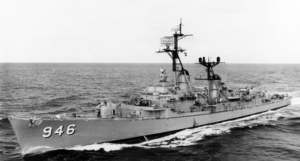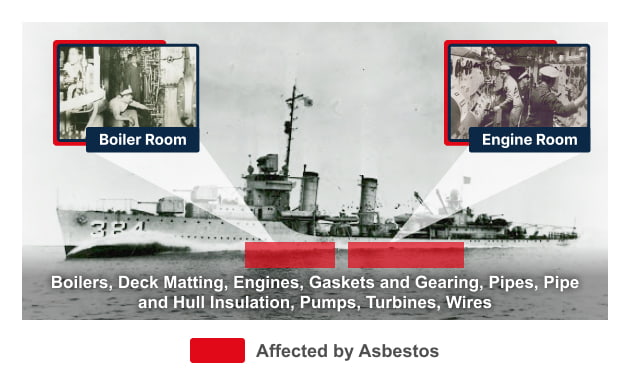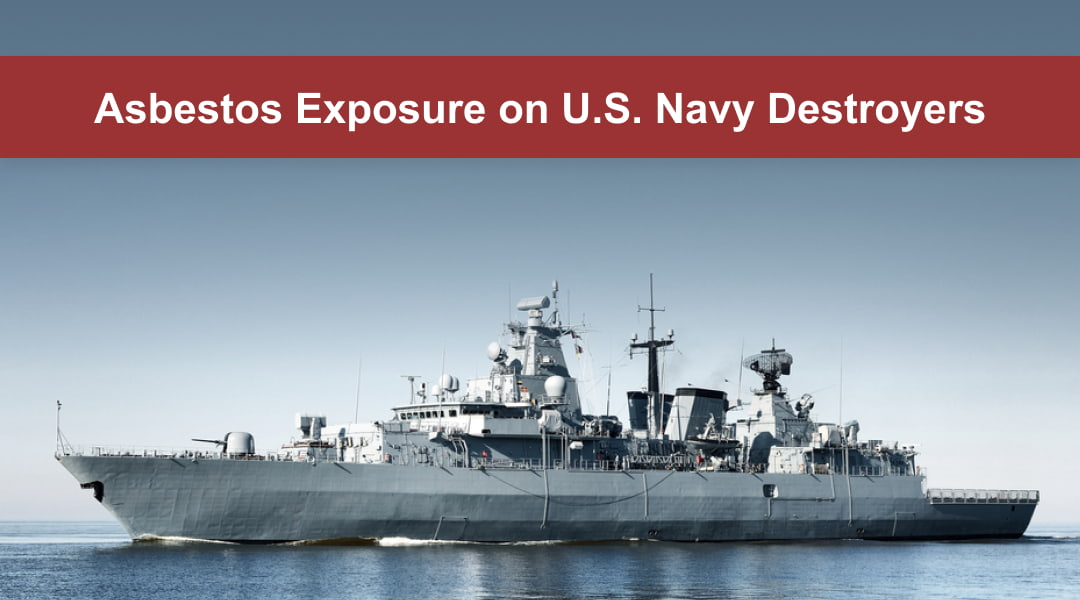Between the 1930s and early 1980s, more than 900 United States Navy destroyers were made with asbestos-based products, exposing thousands of sailors and shipbuilders to this cancer-causing substance. Get help if you developed mesothelioma or another asbestos-related disease after serving on a U.S. Navy destroyer.
Did the U.S. Navy Use Asbestos on Destroyers?
 Yes, almost all Navy destroyers built between the 1930s and early 1980s used asbestos. Asbestos was used aboard destroyers — and thousands of other U.S. Navy ships — because it helped keep the vessels fireproof, well-insulated, and sturdy.
Yes, almost all Navy destroyers built between the 1930s and early 1980s used asbestos. Asbestos was used aboard destroyers — and thousands of other U.S. Navy ships — because it helped keep the vessels fireproof, well-insulated, and sturdy.
However, asbestos exposure is now known to cause life-threatening health issues like mesothelioma. Any U.S. Navy veterans who were exposed to asbestos on destroyers could go on to develop mesothelioma or other illnesses 10-50 years later.
The Mesothelioma Veterans Center can help veterans with mesothelioma that was caused by asbestos on destroyers.
By working with our team, veterans can access:
- Benefits from the U.S. Department of Veterans Affairs (VA)
- Cancer treatments from top doctors
- Legal compensation by filing lawsuits or trust fund claims
Learn more about how we can assist you or a U.S. veteran you love in our Free Veterans Packet.
List of Navy Destroyers With Asbestos
Over 900 destroyers were built with asbestos-containing products before the risks were well-known.
U.S. Navy destroyers confirmed to have used asbestos include:
- USS Abel P. Upshur (DD-193)
- USS Allen M. Sumner (DD-692)
- USS Arnold J. Isbell (DD-869)
- USS Bainbridge (DD-1)
- USS Basilone (DD-824)
- USS Benham (DD-49)
- USS Billingsley (DD-293)
- USS Brown (DD-546)
- USS Burrows (DD-29)
- USS Caperton (DD-650)
- USS Cassin Young (DD-793)
- USS Charles R. Ware (DD-865)
- USS Chew (DD-106)
- USS Cogswell (DD-651)
- USS Cowie (DD-632)
- USS Dallas (DD-199)
- USS Damato (DD-871)
- USS DeLong (DD-129)
- USS Dewey (DD-349)
- USS Douglas H. Fox (DD-779)
- USS Dunlap (DD-384)
- USS Dyson (DD-572)
- USS Earle (DD-635)
- USS Ericsson (DD-440)
- USS Ernest G. Small (DD-838)
- USS Everett F. Larson (DD-830)
- USS Fanning (DD-37)
- USS Farragut (DD-300)
- USS Fechteler (DD-870)
- USS Fife (DD-991)
- USS Floyd B. Parks (DD-884)
- USS Forrest (DD-461)
- USS Gainard (DD-706)
- USS Grayson (DD-435)
- USS Haggard (DD-555)
- USS Helm (DD-388)
- USS Irwin (DD-794)
- USS Izard (DD-589)
- USS James C. Owens (DD-776)
- USS John A. Bole (DD-755)
- USS John Hood (DD-655)
- USS Kane (DD-235)
- USS Kennedy (DD-306)
- USS Killen (DD-593)
- USS Kimberly (DD-521)
- USS Knight (DD-633)
- USS Lamson (DD-367)
- USS Lowry (DD-770)
- USS MacLeish (DD-220)
- USS Manley (DD-74)
- USS Mayo (DD-422)
- USS Moody (DD-277)
- USS Mustin (DD-413)
- USS Nelson (DD-623)
- USS Nields (DD-616)
- USS Norman Scott (DD-690)
- USS O’Hare (DD-889)
- USS Oldendorf (DD-972)
- USS Ordronaux (DD-617)
- USS Palmer (DD-161)
- USS Parsons (DD-949)
- USS Paulding (DD-22)
- USS Peterson (DD-969)
- USS Pope (DD-225)
- USS Ralph Talbot (DD-390)
- USS Remey (DD-688)
- USS Reuben James (DD-245
- USS Sands (DD-243)
- USS Sarsfield (DD-837)
- USS Shannon (DD-737)
- USS Sigsbee (DD-502)
- USS Simpson (DD-221)
- USS Spruance (DD-963)
- USS Stickell (DD-888)
- USS Stump (DD-978)
- USS Tattnall (DD-125)
- USS Thatcher (DD-162)
- USS Uhlmann (DD-687)
- USS Van Valkenburgh (DD-656)
- USS Waldron (DD-699)
- USS Watts (DD-567)
- USS Witek (DD-848)
- USS Yarborough (DD-314)
- USS Zellars (DD-777)
These are just some of the hundreds of destroyers that used asbestos. In total, it's believed that every U.S. Navy ship built before the 1980s may have relied on asbestos-containing products in some way.
Why Was Asbestos Used on Destroyers?
Destroyers needed to be fast and capable of engaging enemy vessels in combat. Since asbestos products were lightweight, resistant to fire, and durable, they were thought to be ideal for use on destroyers.
Asbestos-based materials were also cheap to purchase from private companies. The government even mandated the use of asbestos on destroyers and other naval ships for decades due to the perceived benefits.
Video Summary: U.S. Navy destroyers relied on asbestos, the only known cause of mesothelioma, for decades. Navy veterans could be at risk of mesothelioma if they served on these ships. View Transcript
Between the 1930s and early 1980s, the United States Navy built nearly every destroyer with asbestos-based products. This meant that thousands of sailors and shipbuilders were exposed to this cancer-causing substance on a daily basis.
Navy destroyers relied on asbestos to keep boilers, pipes, turbines, and other parts well insulated and fire resistant.
However, Navy veterans that served on destroyers that used asbestos could develop deadly cancers like mesothelioma and lung cancer 10 to 50 years later. The risks of asbestos were hidden from the military and public for decades. Because of this, those who were exposed to asbestos on U.S. Navy destroyers may not have been aware of the danger they were facing.
If you or a loved one served on a U.S. Navy destroyer and have been diagnosed with mesothelioma, there is help available.
The U.S. Department of Veterans Affairs offers a wide range of benefits — including health care and monthly compensation — to veterans with mesothelioma. Our team can help you file a mesothelioma VA benefits claim now.
We can also connect you to top doctors, financial aid, and additional resources that can help you and your family.
The Mesothelioma Veterans Center stands ready to help if you developed mesothelioma from serving on destroyers or other Navy ships. Reach out to us today.
Asbestos-based products found on destroyers included:
- Boilers
- Cloth used on heaters and steel drums
- Deck matting
- Engines
- Gaskets and gearing
- Pipes
- Pipe and hull insulation
- Pumps
- Turbines
- Wires
Companies that made and sold asbestos-containing products knew of the health risks as far back as the 1930s. But, instead of warning the public, they hid the truth for decades since they wanted to make money.
In the process, these companies put millions of civilians and U.S. veterans at risk of mesothelioma, lung cancer, and other illnesses.
Who Was at Risk of Asbestos on Destroyers?
Any U.S. Navy veteran exposed to asbestos on a destroyer could develop mesothelioma later in life.
If asbestos products on destroyers were damaged or destroyed, microscopic asbestos fibers could be released into the air. Destroyers had poor ventilation, so these fibers could stay in the air for hours and be breathed in or swallowed by those on board.


Service members at the highest risk of asbestos exposure worked in boiler rooms and engine rooms, which were often cramped and filled with asbestos-based parts.
Others at high risk of exposure to asbestos on destroyers included:
- Machinists
- Pipefitters
- Shipbuilders
- Shipyard workers
- Welders
Those aboard Navy destroyers and other vessels were not given proper safety equipment when working with asbestos, since the risks weren’t fully understood.
Asbestos-containing materials were also widely used in shipbuilding, maintenance, and repair. This meant that Navy shipyard workers were also in danger of exposure.
If you developed mesothelioma or another asbestos-related illness from destroyers, the Mesothelioma Veterans Center is here to help. Find out how to access VA benefits, treatments, and compensation in our Free Veterans Packet.
History of U.S. Destroyers and Mesothelioma
Destroyers were prominently used during World War I and up through World War II, the Vietnam War, and the Cold War.
During this time, the vast majority of Navy destroyers used asbestos. However, most Navy service members didn’t realize that asbestos could harm them.
Testimonial“I was a boiler tender when I went aboard my first ship and started doing my first job. I asked them what the material was made out of and they told me it was asbestos. It didn’t kill anybody on the spot, that’s for sure. It took years later — that’s when it started catching up with us.”
The dangers of asbestos came to light in the late 1970s and early 1980s, and major renovation efforts were undertaken to remove asbestos on destroyers and other Navy vessels. Today, no destroyers in service contain the substance.
Even U.S. Navy veterans who served on destroyers decades ago are still at risk of mesothelioma and other asbestos-related diseases, as it takes 10-50 years for mesothelioma to develop after asbestos exposure.
Compensation Options for Veterans With Mesothelioma
U.S. veterans fighting mesothelioma after serving on destroyers may be able to get compensation through VA benefits, lawsuits, and asbestos trust fund claims.
Mesothelioma compensation can be life-changing, allowing veterans to afford potentially life-extending treatments and keep their families financially stable.
Below, learn more about how our team may be able to help you access compensation for asbestos on destroyers.
VA Benefits Claims
The U.S. military offers help to veterans with mesothelioma through VA benefits. Mesothelioma often gets a 100% disability rating through the VA. This gives veterans access to low-cost health care and monthly financial payouts.
For 2024, the VA pays out almost $4,000 a month to married veterans with this cancer through disability compensation. Veterans can also get treatments from top mesothelioma doctors who are within the VA’s health care network.
The Mesothelioma Veterans Center may be able to help you file for VA benefits or increase an existing claim to get 100% disability.
Mesothelioma Lawsuits
Veterans with mesothelioma may be able to file lawsuits to demand compensation from companies that made and sold the asbestos-based products that made them sick. Mesothelioma lawsuits typically pay out $1 million or more.
Eligible U.S. veterans can work with the Mesothelioma Veterans Center to get help filing lawsuits. These lawsuits are never filed against the military or government, and veterans can still get VA benefits in addition to lawsuit compensation.
Recent lawsuits for veterans harmed by asbestos on destroyers have paid out:
- $4.68 million to a veteran from New Hampshire who served on the USS Fred T. Berry
- $3.3 million to a boiler tender from Illinois who developed pleural mesothelioma after serving on the USS
- Mervine, USS Harwood, and USS Sea Runner
- $3.15 million to a Minnesota veteran who spent a decade as a boilerman on the USS Conway and USS Humphreys
- $2.96 million for a veteran from North Carolina who was a machinist mate on the USS Moale
- $2.7 million to an Arizona veteran who served as an electrician’s mate aboard the USS Hamul and USS Lea
Call (877) 450-8973 to see if we can help you file a mesothelioma lawsuit. You may start to get compensation in 90 days or less when you work with our partner law firm.
Asbestos Trust Funds
Some manufacturers of asbestos products filed for bankruptcy to avoid lawsuits, but, it may still be possible to get compensation from these companies through asbestos trust funds.
Asbestos trust funds are sums of money set aside for current and future mesothelioma patients.
As of 2024, these trusts contain over $30 billion, and by filing a claim, veterans can receive trust fund compensation without going to court.
If you were exposed to asbestos on destroyers and are now sick, we may be able to help you pursue asbestos trust fund money, lawsuit compensation, and VA benefits.
Help for Navy Veterans Harmed by Asbestos on Destroyers
The Mesothelioma Veterans Center is here to help veterans and their loved ones facing a mesothelioma diagnosis after exposure to asbestos on destroyers.
No U.S. veteran ever deserves to get cancer simply from serving their country. Yet each year, thousands of veterans are diagnosed with mesothelioma — with many cases tied to asbestos on destroyers and other Navy ships.
With our help, you may be able to:
- Determine if you were exposed to asbestos on destroyers
- File a VA claim or increase your benefits
- Find top mesothelioma doctors near you
- Receive compensation by working with our partner lawyers
- Secure justice for you and your family
Call (877) 450-8973 right now or get a Free Veterans Packet to get started.
Asbestos on Destroyers FAQs
What U.S. Navy ships had asbestos?
Thousands of U.S. Navy ships had asbestos aboard, including over 900 destroyers.
Just a few of these vessels were:
- USS Benham
- USS Kane
- USS Mayo
Any U.S. veteran exposed to asbestos on destroyers or other ships could be at risk of mesothelioma today.
Find out if a ship you served on used asbestos-containing products and get help by contacting our team.
What was asbestos used for in the Navy?
The Navy used asbestos on destroyers and other military vessels to protect them from fire, corrosion, and water damage.
A wide range of products used aboard destroyers relied on asbestos, including insulation, plumbing products, and adhesives, as a result.
Is there still asbestos on Navy ships?
Most U.S. Navy destroyers and other vessels do not have asbestos on board today.
After the risks of asbestos became well-known, nearly all asbestos-containing materials were removed from Naval vessels.
No U.S. destroyers built with asbestos are currently in use by the military, according to the U.S. Naval Vessel Register.
Some older vessels used by the Navy may still have asbestos aboard. In these cases, the asbestos-based products have been secured and don’t pose a threat to active members of the military.
What toxins are on Navy ships?
The most notable toxin used on Navy destroyers and other ships was asbestos.
Asbestos was thought to be a safe material that could help with fireproofing and insulation, but it’s now known to cause cancer.
Veterans who worked aboard ships that were built with asbestos-containing products should be regularly monitored for mesothelioma, lung cancer, and other asbestos-related diseases.
Can you sue the Navy for asbestos exposure?
No, it’s not possible to sue the U.S. Navy or any other branch of the military for asbestos exposure.
However, U.S. veterans who developed mesothelioma may be able to file lawsuits against the asbestos companies responsible for their illnesses.
These lawsuits typically award $1 million or more. Veterans may also be able to get compensation by filing an asbestos trust fund claim or VA disability claim.
Veterans can still get VA benefits if they file a lawsuit. Call (877) 450-8973 for help accessing benefits and legal compensation.



